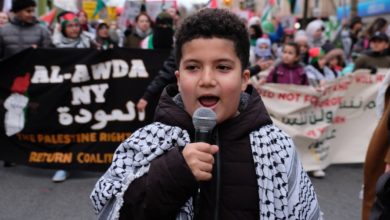A few thousand protesters flooded the streets of Manhattan on Saturday in an outpouring of anger against racist police violence and to show solidarity with the families whose loved one’s lives were cut short by the cops. Dozens of victims’ families from around the country traveled to New York City and led the march, joined by activists, students and others from across the city.
The last year has seen the emergence of the Black Lives Matter movement, with mass protests after the killing of of Michael Brown, Freddie Gray, Rekia Boyd, Sandra Bland, Eric Garner, Akai Gurley, and an unconscionably high number of others.
This demonstration marked the twentieth annual march for October 22, which has become a nationwide day for protests against police brutality since 1996. Many of the marchers on Saturday, however, reported that this was their first time ever attending a demonstration and said that recent high-profile police murders and the uprisings they inspired in places like Ferguson and Baltimore made them want to come out and become involved.
Michelle Locke, a journalism student at Rutgers, said she first felt a need to became involved after the acquittal of Trayvon Martin’s murderer. She spoke with Liberation News about the importance of this moment in the movement, “The whole system has to change,” Locke said. “and that’s something that has never been tackled in all of the decades that it’s been a problem. But I feel like now, there are enough people that are angry, enough people that want change that it can happen.”
Every 28 hours in the United States, a Black man, woman, or child is murdered by a police officer or vigilante. Fewer than 1% of police officers ever face conviction for these murders, often enjoying paid administrative leave before eventually returning to patrol duty. Racist police violence deeply compounds other forms of state racism, like mass incarceration, which piles heavily on top of the many other challenges facing working class people in the United States around issues like jobs, housing, and education.
These issues become compounded further still for individuals with multiple marginalized identities. “Queer, lesbian, and trans Black people are constantly being dehumanized, constantly receiving violence from the state,” Simone Sobers, a member of the Audre Lorde Project, told Liberation News. “I can’t fight for Black Lives Matter and not include my trans sisters. I’m empowered by them, and they’re a part of my community. They’re the people who have been fighting about this very issue, for years, for decades, so they’re 100% Back Lives Matter.” Sobers mentioned feeling particularly moved to action by the case of Yvonne McNeal, a Black lesbian woman who was murdered by the NYPD in 2011. Her killers have yet to be brought to justice nor adequate information given to her family about the circumstances of her death.
Demonstrators gathered in the morning around Washington Square Park, where the families of people killed by police spoke out before the crowd. The march then moved up Sixth Avenue, chanting, “For Akai Gurley and Michael Brown, shut it down, shut it down!” and “Racists beware! Ferguson is everywhere! At times, marchers chanted, “From Ferguson to Palestine, occupation is a crime,” making the international connection between racist police violence in the United States and the renewed upsurge of violence against Palestinians in recent weeks. Throughout the march, the NYPD, visibly wary of the highly-organized masses of mobilized demonstrators, trailed along in a display of ample force, at times attempting to intimidate protesters to leave the streets. Marchers, however, remained militant and refused police orders to move onto the sidewalk, chanting, “Whose streets? Our streets!”
“Murder is murder, no matter if you have a badge or not,” Yari Osorio, a member of the Party for Socialism and Liberation, told Liberation News as the march drew to a close. “Police need to be held accountable. We see the police right now as not actually serving the people but being an agent of social control, a tool of the 1%. But we’re going to unite with each other, and we’re going to rise up against them and fight for something much better than what we have now.”






